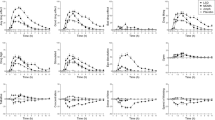Summary
Low doses of the dopamine agonist ET-495 were administered to non-psychotic volunteer subjects by slow intravenous infusion, followed by a bolus of 1.5–2.5 mg haloperidol. ET-495 caused progressive dysphoria and sedation (in some cases, light sleep), effects believed to be mediated by dopaminergic inhibition. However, ET-495 also elevated growth hormone and suppressed prolactin, typical responses to dopamine agonist activity. Haloperidol reversed both the sedation and prolactin suppression induced by ET-495. These findings suggest: (1) that the sedation and hormonal responses were produced by stimulation of dopamine receptors; (2) that neurotransmitter systems mediating behavioral and neuroendocrine regulation may have differential neuropharmacological characteristics.
Similar content being viewed by others
References
Andén, N.-E., Strömbom, U., Svensson, T. H. Locomotor stimulation by L-DOPA: Relative importance of noradrenaline receptor activation. Psychopharmacology54, 243–248 (1977).
Angrist, B., Thompson, H., Shopsin, B., Gershon, S. Clinical studies with dopamine-receptor stimulants. Psychopharmacologia (Berl.)44, 273–280 (1975).
Angrist, B., Urcuyo, L., Gershon, S. Response to incremental doses of ditran in abstinent alcoholics and drug users. Comprehens. Psychiat.15, 201–204 (1974).
Bleuler, E. Dementia Praecox or the group of schizophrenias (1911). Translated by J. Zinkin, p. 486. New York: International Universities Press. 1950.
Carlsson, A. Receptor-mediated control of dopamine metabolism. In: Preand Postsynaptic Receptors (Usdin, E., Bunney, W., eds.), pp. 49–63. New York: Marcel Dekker. 1975.
Castaigne, P., Laplane, D., Dordain, G. Clinical experimentation with apomorphine in Parkinson's Disease. Res. Comm. Clin. Path. Pharm.2, 154–158 (1971).
Cools, A., Van Rossum, J. M. Excitation-mediating and inhibition-mediating dopamine receptors: a new concept toward a better understanding of electrophysiological, biochemical, pharmacological, functional and clinical data. Psychopharmacologia45, 243–254 (1976).
Corsini, G. U., Del Zompo, M., Manconi, S., Ciancbetti, C., Manzoni, A., Gessa, G. L. Sedative, hypnotic and antipsychotic effects of low doses of apomorphine in man. Advances in Biochem. Psychopharm.16, 645–653 (1977).
Cotzias, G. C., Papavasiliou, M. D., Tolosa, N. D., Mendez, J. S., Bell-Midura, M. Treatment of Parkinson's disease with apomorphines. Possible role of growth hormone. New Engl. J. Med.294, 567–572 (1976).
DiChiara, G., Porceddu, M. L., Vargiu, L., Argiolas, A., Cessa, G. L. Evidence for dopamine receptors mediating sedation in the mouse brain. Nature264, 564–567 (1976).
Douglas, C. J.: Alcoholism. N.Y. Med. J.1899, 626–628.
Duby, S. E., Cotzias, G. C., Papavasiliou, P. S., Lawrence, W. H. Injected apomorphine and orally administered levodopa in Parkinsonism. Arch. Neurol.27, 474–480 (1972).
Ettigi, P., Nair, N. P. V., Lal, S., Cervantes, P., Guyda, H. Effect of apomorphine on growth hormone and prolactin secretion in schizophrenic patients, with or without oral dyskinesia withdrawn from chronic neuroleptic therapy. J. Neurol Neurosurg. and Psychiat.29, 870–876 (1976).
Feldman, F., Susselman, S., Barrera, S. E. A note on apomorphine as a sedative. Amer. J. Psychiat.102, 403–405 (1945).
Garattini, S., Bareggi, S. R., Marc, V., Calderini, G., Morselli, P. L. Effects of piribedil on noradrenaline and MOPEG-SO4 levels in the rat brain. Europ. J. Pharmacol.28, 214–216 (1974).
Goldstein, M., Freedman, L. S., Backstrom, T. The inhibition of catechol-amine biosynthesis by apomorphine. J. Pharm. Pharmacol.22, 715–717 (1970).
Langer, G., Sachar, E. J., Halpern, F. S., Gruen, P. H., Solomon, M. The prolactin response to neuroleptic drugs. A test of dopaminergic blockade: Neuroendocrine studies in normal men. J. Clin. Endocr. and Metab.45, 996–1002 (1977).
Langer, G., Sachar, E. J., Nathan, S., Tabaizi, M. A., Perel, J. M., Halpern, F. S.: Human prolactin responses to dopamine and neuroleptics. (Submitted for publication.)
Laue, K., Gottlieb, C. W., Herbert, V. Preliminary report on coated charcoal immunoassay of human chorionic “growth hormone-prolactin” and growth hormone. Proc. Soc. Exp. Biol. Med.123, 126–131 (1966).
Mac Leod, R. M. Regulation of prolactin secretion. In: Frontiers in Neuro-endocrinology (Martini, L., Ganong, W. F., eds.), pp. 169–194. New York: Raven Press. 1976.
Maj, J., Grabowska, M., Gajda, L. Effect of apomorphine on motility in rats. Europ. J. Pharmacol.17, 208–214 (1972).
Nyback, H., Schuler, J., Sedvall, G. Effect of apomorphine and pimozide on synthesis and turnover of labelled catecholamines in mouse brain. J. Pharm. Pharmacol.22, 622–624 (1970).
Persson, T., Waldeck, B. Further studies on the possible interaction between dopamine and noradrenaline containing neurons in the brain. Europ. J. Pharmacol.11, 315–320 (1970).
Rotrosen, J., Angrist, B., Gershon, S., Sachar, E. J., Halpern, F. S. Dopamine receptor alteration in schizophrenia: neuroendocrine evidence. Psychopharmacology51, 1–7 (1976).
Schwab, R. S., Amador, L. V., Lettvin, J. Apomorphine in Parkinson's disease. Trans. Amer. Neurol. Assn.76, 251–253 (1957).
Sinha, Y. N., Selby, F. W., Lewis, U. J., Vander Lann, W. P. A homologous radioimmunoassay for human prolactin. J. Clin. Endocr. and Metab.36, 509–516 (1973).
Strian, F., Michler, E., Benkert, O. Tremor inhibition in Parkinson syndrome after apomorphine administration under L-DOPA and decarboxylase inhibitor basic therapy. Pharmakopsychiat.5, 198–205 (1972).
Stromberg, U. DOPA effects on motility in mice; potentiation by MK 485 and dexchlorpheniramine. Psychopharmacologia18, 58–67 (1970).
Strömbom, U. Antagonism by haloperidol of locomotor depression induced by small doses of apomorphine. J. Neural Transm.40, 191–194 (1977).
Tompkins, J. E. Apomorphine in acute alcoholic delirium. Med. Rec.55, 56 (1899).
Vogt, M. The concentration of sympathin in different parts of the central nervous system under normal conditions and after the administration of drugs. J. Physiol.123, 451–481 (1954).
Author information
Authors and Affiliations
Rights and permissions
About this article
Cite this article
Angrist, B., Ain, M., Rotrosen, J. et al. Behavioral and neuroendocrine effects of low dose ET-495: Antagonism by haloperidol. J. Neural Transmission 44, 249–262 (1979). https://doi.org/10.1007/BF01250321
Received:
Issue Date:
DOI: https://doi.org/10.1007/BF01250321




